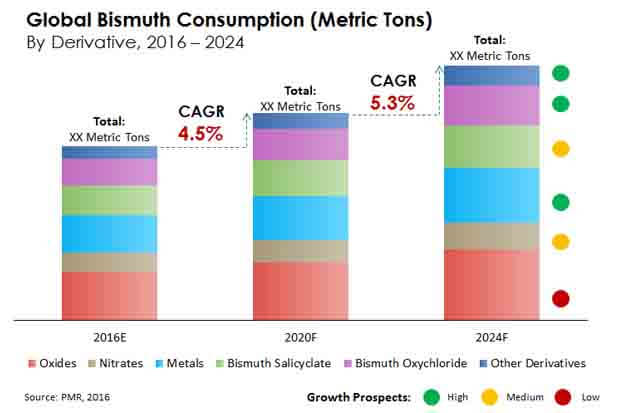Bismuth Market Segmented By Oxides, Nitrates, Metals Bismuth, Salicylate Bismuth, Oxychloride Derivative in Pharmaceuticals, Cosmetics, Industrial Pigments, Metallurgical Additives, Fusible Alloys
Industry: Chemicals and Materials
Published Date: July-2016
Format: PPT*, PDF, EXCEL
Delivery Timelines: Contact Sales
Number of Pages: 177
Report ID: PMRREP4398
Bismuth, a least toxic heavy metal resembles with lead in many of its characteristics. It is the most diamagnetic material known, which is found naturally. This white crystalline metal finds applications in the diverse set of industries. It is found in nature in the form of bismite, bismuthinite, or bismutite minerals. However, more commonly produced as a refining by product of lead. Pellets, powder, needle, ingots forms of bismuth are used for commercial applications across the industries.
“Pharmaceuticals” is a prominent application of bismuth, where it is used as an indigestion remedy under the brand name Pepto-Bismol. Additionally, bismuth also finds application in color cosmetics, industrial pigments, metallurgical additives, and fusible alloys. Most of the bismuth applications use bismuth in small quantities.
Moreover, end user chemical industries namely, cosmetics, pharmaceuticals, and industrial pigments use bismuth compounds which are derived from bismuth. Bismuth oxides, nitrates, bismuth salicylate, bismuth oxychloride are prominent derivatives of bismuth metals.
Other bismuth derivatives include bismuth vanadate, bismuth sulphides, and bismuth acetate. Bismuth oxides and bismuth nitrates are the most protruding derivatives and are generally used as a source of bismuth to produce various high purity bismuth compounds.
Global bismuth market reached close to US$ 225 Mn in 2016 and is projected to expand at a moderate single-digit CAGR in terms of value during the forecast period, 2016-2024.
Bismuth having resembling characteristics with lead and having least toxic effects on human health is anticipated to replace lead in numerous applications. Bismuth market growth is estimated to be driven by increasing government regulations to restrict the use of lead in various end-use industries namely, paints & coatings, alloys, and electronics. The renovation, repair, and painting (RPR) programme by Environmental Protection Agency and REACH regulations are instances of such restrictions by governments in North America and Europe.
Major end-use manufacturers such as BASF SE and PPG Inc. are offering bismuth-based products as an alternative for lead products, in order to provide environmentally friendly offerings. POSCO which has a production capacity of 1.5 Mn metric tons of lead-based free machining steel is set to replace it by bismuth-based free machining steel.
The growing automotive industry which includes the application of bismuth in rust free coatings, pearlescent coatings, brake linings, and clutch pads is also anticipated to provide traction for the increasing bismuth market demand over the forecast period. Moreover, the increasing base metal tungsten production is anticipated to increase bismuth supply in the market. The production of tungsten in the global market by non-Chinese producers is expected to increase in near future which in turn will drive the bismuth supply in the global market.
However, the production of lead which is a prominent source of bismuth supply is estimated to decline due to the regulations and decreasing consumption of lead acid batteries in the global market. This declining lead production is estimated to be a major restraint in global bismuth market growth over the forecast period.
Moreover, the increasing use of alternatives namely alumina and magnesia in pharmaceuticals application and use of tungsten and tin in alloys application is anticipated to be a major obstacle to the market growth. The new entrants venturing in with high production capacity is anticipated to be a prominent trend in the market. Additionally, Use of bismuth in a high-tech application such as wearable technology and as an anode for Sodium-Ion Batteries (SIB) is another protruding trend in the global market.
Global bismuth market is segmented as follows:
By derivative, global bismuth market is segmented into oxides, nitrates, metals, bismuth salicylate, bismuth oxychloride, and others. Bismuth oxide segment is anticipated to continually dominate the market share in terms of volume, over the forecast period.
On the basis of application, the global bismuth market is classified as pharmaceuticals, cosmetics, industrial pigments, metallurgical additives, fusible alloys, and others. Among these segments, pharmaceuticals are the most prominent segment in the global bismuth market.
Bismuth oxychloride and metals segments are anticipated to collectively expand at a CAGR of 7.0% over the forecast period; this is higher than the global average market growth rate. The two segments are anticipated to create the cumulative incremental $ opportunity of US$ 62.2 Mn between 2016 and 2024. The nitrates and bismuth salicylate segments are anticipated to exhibit relatively low CAGR over the forecast period.

On the basis of regions, the global bismuth market is segmented into key regions, namely, North America, Latin America, Europe, APAC, Middle East and Africa. Asia Pacific is anticipated to be the dominating market in terms of value and volume, over the forecast period.
Key players identified in this report are Martin Marietta Inc., Hunan Jinwang Bismuth Industry Co. Ltd, Hunan Bismuth Co. Ltd, Hunan YuTeng Nonferrous Metals Co., Ltd., Met-Mex Peñoles, S.A. de C.V., 5N Plus Inc., Hunan YuTeng Nonferrous Metals Co., Ltd., Nui Phao Mining Company Limited.
| derivative |
|
| application |
|
| Regionally |
|
To know more about delivery timeline for this report Contact Sales
